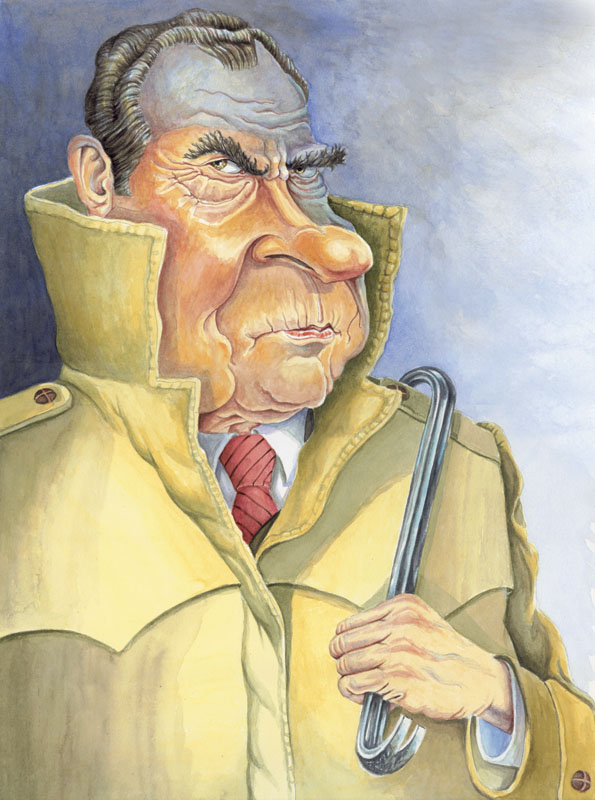Watergate was “the ultimate stress test” for the nation, says Timothy Naftali, director of the Nixon Library. It was also a stress test for the National Archives and the Nixon Library.
The Nixon Presidential Library and Museum’s original exhibit about Watergate, designed in 1990 by Nixon loyalists before the National Archives took over operation of the library, explained Watergate as a third-rate burglary exploited by the president’s enemies to reverse the results of the 1972 election.
Now, with the long-awaited opening of the library’s new Watergate exhibit, the public finally has a museum that tells the full story of what President Ford called “our long national nightmare” — and tells it with authority and rich detail, mobilizing up-to-the-minute interactive technology that might even engage middle school students brought here on tours.
That story is still devastating. The exhibit makes clear how, with the country in turmoil over an unpopular war, the president became obsessed with “enemies” and formed a secret unit, “the plumbers,” to carry out illegal assignments.
When its members got arrested breaking into the offices of the Democratic National Committee, the president discussed paying them hush money, talked about how to pardon them before they could tell their story, and then ordered the CIA to tell the FBI to stop its investigation of presidential wrongdoing.
In the end, the constitutional system of checks and balances worked.
A Senate committee uncovered the White House taping system; the Supreme Court ordered the release of tapes containing key evidence of the cover-up attempt; the House Judiciary Committee voted for articles of impeachment, starting with obstruction of justice. And the president resigned rather than face removal from office because his own party had turned against him in the Senate.
In Yorba Linda, Calif., the new exhibit consists not of long panels of explanatory text but of vivid interactive video displays in which participants, witnesses and observers tell the story from their perspectives.
For each “chapter” of the story, visitors can select excerpts from interviews (a total of 40 hours of interactive content, 131 interviews on video conducted by the library for this exhibit), including central figures G. Gordon Liddy, head of the plumbers unit; presidential adviser Charles Colson; Alexander Butterfield, the White House assistant who recalls how he revealed the White House taping system; and Sen. Trent Lott, then a Republican member of the House Judiciary Committee, who recalls seeing the first transcript of the “smoking-gun tape” and concluding that “one article of impeachment for obstruction of justice was going to be inevitable.”
One of the biggest innovations in Yorba Linda concerns the starting point for the Watergate story.
Textbooks and journalists usually begin with the break-in at the offices of the Democratic National Committee during the 1972 campaign. But the Nixon Library exhibit starts much earlier, in July 1971, with the publication of the Pentagon Papers, the secret history of the war leaked by Daniel Ellsberg, which led to Nixon’s obsession with leaks and to his formation of the “plumbers” unit, ostensibly to stop them.
Their first assignment was to get dirt on Ellsberg by breaking into the offices of his psychiatrist. The same unit then went on to break into the offices of the Democratic National Committee at the Watergate complex. Thus the abuse of power by the president didn’t begin with the election campaign, but started more than a year earlier.
Another innovation concerns the end of the Watergate story. Textbooks and journalists almost always conclude with Ford’s pardon of Nixon. But the Nixon Library goes one big step further, closing with the legislation that resulted from Watergate: the broadening of the Freedom of Information Act to give individuals and journalists more tools to uncover government abuse of power; the Presidential Records Act, which forbids presidents from destroying their records; the creation of the Federal Election Commission to monitor campaign finance; and the Ethics in Government Act, which established the office of the special prosecutor.
A final, crucial innovation is the museum’s emphasis on the many people within the government who refused to carry out orders from the president that were illegal. “Their story is now preserved,” says Naftali, who curated the exhibit. “Students who come here will learn that you can say no when asked to say or do something that’s wrong.”
Highlights here include Treasury Secretary George P. Shultz describing how he refused a president’s order to audit the tax returns of anti-war Democrats, and Chief of Staff Alexander Haig saying he refused Nixon’s request to burn the tapes.
Finally, visitors can also learn Nixon’s version. At the end comes a panel, “The View From San Clemente,” where we get Watergate in Nixon’s own words — in his TV interview with David Frost, and in his bestselling memoir “RN.”
Historians often complain that presidential libraries tend to present rosy pictures of former presidents, ignoring anything controversial. The Nixon Library’s original Watergate exhibit was one of the worst offenders.
It took a long time, but at the new Watergate exhibit at the Nixon Library, our long national nightmare really is over — at last.
Jon Wiener teaches history at UC Irvine and is a contributing editor to the Nation. He wrote this for the Los Angeles Times.
Copy the Story Link
Send questions/comments to the editors.



Success. Please wait for the page to reload. If the page does not reload within 5 seconds, please refresh the page.
Enter your email and password to access comments.
Hi, to comment on stories you must . This profile is in addition to your subscription and website login.
Already have a commenting profile? .
Invalid username/password.
Please check your email to confirm and complete your registration.
Only subscribers are eligible to post comments. Please subscribe or login first for digital access. Here’s why.
Use the form below to reset your password. When you've submitted your account email, we will send an email with a reset code.